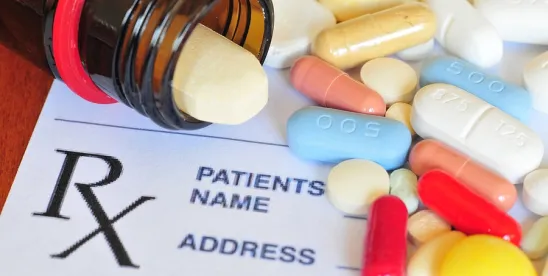Developments in 2018
Compounding
In 2018, FDA issued six final and three draft or revised draft guidance documents on compounded drugs. The final guidance documents address:
-
Compounded drug products that are essentially copies of commercially available drug products under FDCA sections 503A (compounding by licensed pharmacists or physicians for identified individual patients based on valid prescription orders) and 503B (compounding in an outsourcing facility) (collectively, copies)
-
The facility definition under section 503B
-
The compounding and repackaging of radiopharmaceutical by state-licensed nuclear pharmacies, federal facilities and outsourcing facilities
-
Adverse event reporting for outsourcing facilities
The draft and revised draft guidance documents cover insanitary conditions, evaluation of bulk drug substances under section 503B, and current good manufacturing practice (cGMP) for 503B outsourcing facilities. Below, we address three guidance documents with significant implications for 503A and 503B compounders, the 503A and 503B copies final guidance documents, and the revised draft guidance on insanitary conditions.
Sections 503A and 503B contain different statutory provisions regarding what constitutes a compounded drug product that is essentially a copy of a commercially available drug product. Under 503A, a compounder must not compound regularly or in inordinate amounts drug products that are essentially copies of a commercially available drug. A drug is not essentially a copy if there is a change, made for an identified individual patient that produces for that patient a significant difference, as determined by the prescribing practitioner, between the compounded drug and the commercially available drug. In the Compounded Drug Products That Are Essentially Copies of a Commercially Available Drug Product Under Section 503A of the Federal Food, Drug, and Cosmetic Act guidance (503A Copies Guidance), FDA explains its interpretations of statutory terms, such as “essentially a copy,” and describes the ways in which a prescriber must document his or her determination that the compounded drug will produce a significant difference for the identified individual patient (e.g., no dye, patient allergy). The significant difference must be produced by the change between the compounded drug and the commercially available drug. Compounding pharmacists and physicians will need to examine their documentation practices in light of this guidance.
Under 503B, a compounded drug must not be essentially a copy of one or more approved drugs. A compounded drug is essentially a copy if it is identical or nearly identical to a marketed unapproved over-the-counter (OTC) drug or an approved drug that is not on FDA’s shortage list at the time of compounding, distributing or dispensing. A compounded drug is also essentially a copy if it is not identical or nearly identical, but has a bulk drug substance that is a component of a marketed unapproved OTC drug or an approved drug, unless the prescriber determines that there is a change in the compounded drug that produces a clinical difference for an individual patient. In the Compounded Drug Products That Are Essentially Copies of Approved Drug Products Under Section 503B of the Federal Food, Drug, and Cosmetic Act guidance (503B Copies Guidance), FDA stated that it will consider a compounded drug identical or nearly identical if the compounded drug and the FDA-approved drug have the same active ingredient(s), route of administration, dosage form, dosage strength, and excipients. If the approved drug is on FDA’s drug shortage list at the time of compounding, distributing or dispensing, then the compounded drug will not be essentially a copy and may be compounded, provided that section 503B’s other requirements are satisfied.
As with the 503A Copies Guidance, the 503B Copies Guidance details what documentation of a prescriber’s determination of clinical difference is acceptable if the compounded drug is not identical or nearly identical but contains the same bulk drug substance as a marketed unapproved OTC drug or an approved drug. Outsourcing facilities must obtain statements from prescribers that specify the change between the compounded drug and the approved drug, and such statements must indicate that the compounded drug will be administered or dispensed only to patients for which the drug will produce a clinical difference. Outsourcing facilities and prescribers must ensure that their documentation for individual patients complies with FDA’s suggested documentation practices.
Neither 503A nor 503B compounding facilities are exempt from FDCA requirements with respect to drugs that are prepared, packed or held under insanitary conditions whereby the drugs may have been contaminated or rendered injurious to health. In September, FDA released its revised draft Insanitary Conditions at Compounding Facility guidance, which sets forth detailed examples of insanitary conditions (e.g., visible microbial contamination, failing to disinfect or change gloves frequently to prevent contamination). State board of pharmacy inspections frequently document conditions such as those identified in the insanitary conditions guidance, and compounders should be aware of that the presence of insanitary conditions poses federal risks as well if compounders do not implement appropriate corrective actions. The guidance reiterates that FDA may take enforcement actions if compounders prepare, pack or hold drugs under insanitary conditions.
Looking Ahead to 2019
In 2019, the agency may finalize some or all of the above draft or revised draft guidances, as well as the 2016 draft guidance on hospital and health system compounding. We also anticipate that FDA will propose rules on the bulk drug substances list under section 503A and modifications to the withdrawn or removed list under sections 503A and 503B. Additionally, FDA is developing a revised draft memorandum of understanding (MOU) in consultation with the National Association of Boards of Pharmacy on the distribution of inordinate amounts of compounded drug products interstate that, once finalized, may be signed by the states. Under the MOU, a state must provide for appropriate investigations of complaints related to compounded drug products distributed outside the state. The comment period on the MOU recently ended, and FDA will publish the final MOU and offer it to states to consider signing it before FDA begins to enforce the statutory five percent limit on distribution out-of-state for compounders in states that have not signed the MOU.
Read more on FDA 2018 Year in Review.







 />i
/>i
